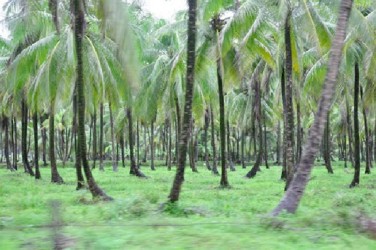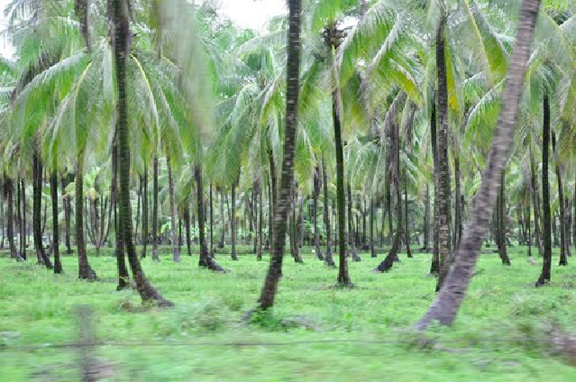At the end of last year the global coconut craze caught the eye of Time Magazine. In a brief article it described the rise of the coconut oil industry in Sri Lanka. Other international publications have published articles on pop icon Madonna’s endorsement of coconut water. However, it is mostly the big Asian players that are cashing in on the market.
This growing global market demand for coconut and coconut products has encouraged the government to take several tilts at seeking to revive the sector. Among recent initiatives was a seminar on the industry hosted by Agriculture Minister Dr Leslie Ramsammy in January and a ‘coconut expo’ held last Friday. The January event, which had targeted stakeholders in the industry from Region Two to Region Six attracted coconut oil millers, copra producers and vendors in the coconut water trade and sought to have stakeholders produce a plan for the revitalisation of the sector.
Ramsammy has since established an oversight committee to make recommendations on the way forward for the sector.

Meanwhile, Julian Jones, who owns a coconut estate at Mahaicony, applauds official efforts to revive the sector, but says it will not be easy. The problem, he says, at least the primary one, would be to persuade those owners who have long abandoned coconut cultivation to return to the pursuit.
No one – not least the proprietors of the sprawling coconut groves along sections of the East Coast and West Coast Berbice it seems – appeared to have anticipated that the coconut sector could ever re-emerge as one of the country’s largest industries. Now that it seems this could happen, the sector itself – or at least large swathes of it – appears to have been taken by surprise.
Evidence of the decline in the local industry is readily apparent in the coastal coconut groves, acres upon acres of which have fallen into a condition of deterioration, their owners having long abandoned the pursuit of coconut cultivation. The lands lie idle, their tenants being mostly cattle and dense vegetation. Some of the original owners have migrated.
Jones recalls his own days – up to two years ago – of exporting copra to Saint Lucia and the impact of changing fortunes on his enterprise. The factory owner in Saint Lucia decided one day to switch allegiance to one of his local competitors. He had no choice but to call it a day.
The writing, he said, had been on the wall for estate owners for some time. Rising costs included increased rates for pickers and labour costs associated with cleaning the land and network of drains that comprise the estates had made the pursuit increasingly unprofitable and the absence of the technology associated with value-added pursuits presented their own challenges.
Jones says that coastal estates like his own are vast tracts of land – some estates can measure as many as hundreds of acres – that can quickly become unmanageable. Local coconut estates, he says, are usually configured in such a way that they must be cleaned manually. Accordingly, any attempt to restore run-down estates will incur prohibitive costs. These days, weeding alone can cost up to $10,000 an acre. “Multiply that by a few thousand acres and see what you get. It’s going to be costly to bring back those estates,” he says.
For the past three years farmers have been benefiting from increased prices and bigger markets in the region, notably in the Dominican Republic. During that period prices have risen by an estimated 75 per cent and it is believed that up to around 70 per cent of local coconuts find their way onto the external market. The New Guyana Marketing Corporation claims some credit for putting local farmers and external buyers together.
In Mahaicony, landless cash crop farmers squat on small portions of long-abandoned coconut estates, cultivating vegetables. In some instances the owners are not around to pass judgment. In other instances the owners are aware of the trespass but assume a posture of indifference. They may not begrudge the farmers a living though the occupancies are illegal. Some of the estates have long been up for sale but no one seems interested.
Jones’ estate is not for sale. He continues to take what advantage he can of the local market for coconuts, while using portions of the land for his own cash crop cultivation. He says he is keeping “an open mind” on the future of the coconut industry. “Perhaps in five to ten years,” is his estimation for the rebirth of the sector.
Meanwhile, last Friday’s coconut expo hosted by the New Guyana Marketing Corporation appeared intended to provide a microcosm of the array of products that can be produced from coconut. The coconut expo appeared to be well-supported. Hassan told Stabroek Business on Wednesday that there is renewed interest in the export potential of coconut water, coconut oil and new interest in the virgin coconut oil and other value-added products. Modest coconut water markets have been found in the region.
Hassan says there may also be an external “shout” for locally produced virgin coconut oil extracted from copra, by grating then drying the meat to reduce its moisture content. Virgin coconut oil is reportedly used extensively in the global health and beauty industries.
Hassan says that there are approximately 24,000 hectares of coconut grove under cultivation and around 60 per cent of those are located in Region Two, mostly along the banks of the Pomeroon River.






